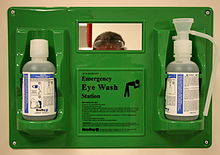Eyewash
This article needs additional citations for verification. (May 2014) |

Eyewash is a fluid, commonly saline, used in the aid of rinsing of the eye.[1] Eyewash may also describe the apparatus used to physically wash the eyes in the case that they may be contaminated by foreign materials or substances.
Eyewashes may be beneficial to those with sensitive eyes and can provide relief to the painful side effects of sensitivity. However, prolonged usage of such products will cause mild side effects, such as the reddening of the eye and/or pupil and cause itchiness. If such symptoms occur, it is best to see one's family doctor.
Occupational Safety
The Occupational Safety and Health Administration (OSHA) was created as a result of the Occupational Safety and Health act of 1970. The law was created to help further protect employee safety while providing “safe & healthful working conditions." OSHA’s primary eyewash standard, 29 CFR 1910.151 states, “where the eyes or body of any person may be exposed to injurious corrosive materials, suitable facilities for quick drenching or flushing of the eyes and body shall be provided within the work area for immediate emergency use.”
OSHA provides additional regulations for battery charging stations in 29 CFR 1926.441(a)(6) “Facilities for quick drenching of the eyes and body shall be provided within 25 feet (7.62 m) of battery handling areas."
Depending on your facility and your type of business, OSHA inspections can be scheduled on a regular basis or may be conducted randomly without prior notice. Inspections are also common as a result of an accident within the workplace. If a violation is found during an OSHA inspection, the consequence may range from a warning, monetary fine or even a plant shut-down.[2]
Eyewash in the Workplace
If an employee gets foreign particles or chemicals in his/her eyes, then an emergency eye wash station or deluge shower is the first step of first aid treatment. If it is an actual chemical burn to the eye, then your emergency will be much more urgent. The employee should be immediately escorted to an eye wash station or deluge shower if:
- The Material Safety Data Sheet (MSDS) identifies the chemical being used is toxic, caustic, or corrosive.
- The MSDS indicates that serious eye injuries will result if the condition is not treated immediately.
- Container labels have warnings such as “Causes Chemical Burns” or “Causes Permanent Eye Damage."
Along with this, eye wash stations and deluge showers must contain the following:
- Pure, clean water.
- The ability to operate them without hands.
- Constant water flow for a period of 15 minutes.
- Unobstructed access.
- Highly visible signs and markings.[3]
References
- ^ http://www.thefreedictionary.com/eyewash
- ^ "EyewashDirect.com | Eyewash Regulations | ANSI Eyewash | OSHA Eye Wash". www.eyewashdirect.com. Retrieved 2015-11-04.
- ^ "Emergency Eye Wash Stations | The Importance Of Eye Wash Stations And Deluge Showers In The Workplace - Safety Partners LTD". Safety Partners LTD. Retrieved 2015-11-04.
